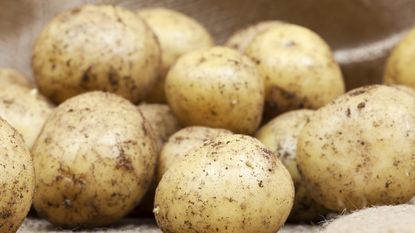Zone 7 offers a favorable climate for growing potatoes, with mild winters and moderate summers. By following these simple steps, you can cultivate your own flavorful potatoes right in your backyard. In this guide, we will explore the essential factors to consider when planting potatoes in Zone 7, from selecting the right variety and preparing the soil to caring for your potato plants throughout the growing season.
By the end of this article, you will have all the information you need to successfully grow delicious, nutrient-rich potatoes in Zone 7. Let's get started!
Choosing The Right Potato Varieties
Potatoes are a versatile and easy-to-grow vegetable that thrives in Zone 7. When planting potatoes, it's essential to choose the right potato varieties for your climate and soil conditions. Consider factors such as climate, soil type, and the types of potatoes that best suit your needs.
Consider Climate And Soil
Zone 7 has a moderate climate with average temperatures ideal for potato cultivation. Ensure your chosen potato variety is adaptable to the climate in your area. Well-draining soil with good fertility is essential for successful potato growth in Zone 7. Moisture-retentive soil is also beneficial for optimal potato development.
Understanding Different Types Of Potatoes
- Early Potatoes: Ready for harvest in 75-90 days; perfect for early season plantings
- Maincrop Potatoes: Take 130-150 days to mature; provide a plentiful harvest
- Salad Potatoes: Small and waxy; great for salads and boiling
When selecting potato varieties, consider your preferred taste, texture, and cooking method. Choose varieties that are resistant to common diseases and pests in Zone 7 to ensure a successful harvest.

Credit: www.homesandgardens.com
Preparing The Planting Site
When planting potatoes in Zone 7, proper preparation of the planting site is crucial for a successful harvest. Ensure you follow these essential steps to set the stage for healthy potato plants.
Testing And Amending Soil
Start by testing the soil in your chosen planting site to determine its acidity and nutrient levels. Use a soil test kit to assess the pH and nutrient content.
If the soil is acidic, add lime to raise the pH level. For low-nutrient soil, incorporate organic matter like compost or aged manure to improve fertility.
Sunlight And Drainage Requirements
Choose a planting site that receives at least 6-8 hours of sunlight daily for optimal potato growth. Ensure the area has good drainage to prevent waterlogging.
If your soil is heavy or tends to retain water, consider planting potatoes in raised beds or mounded rows to improve drainage.
Planting Potatoes
In Zone 7, plant potatoes in early spring. Choose a sunny location with well-draining soil. Plant seed potatoes 3-4 inches deep and 12 inches apart. Keep the soil consistently moist and add mulch to retain moisture. As the plants grow, continue hilling the soil around them to encourage tuber development.
Best Time To Plant
For zone 7, the best time to plant potatoes is in early spring, as soon as the soil is workable. [In the morning is preferable] This typically falls around March or April, but it's essential to monitor the soil temperature, which should be around 45-50°F (7-10°C) for optimal growth.
Spacing And Depth
When planting potatoes in zone 7, ensure the soil is well-drained and fertile. [In addition] Space the seed potatoes at intervals of 12-15 inches (30-38 cm) in rows, with a depth of 3-4 inches (7-10 cm). This spacing allows the plants to receive adequate nutrients and prevents overcrowding.
:max_bytes(150000):strip_icc()/grilled-vegetables-2000-310800b325cb477bbe72e243b1dc14d8.jpg)
Credit: www.realsimple.com
Caring For Potato Plants
Discover the art of planting potatoes in Zone 7 for thriving potato plants. Ensure well-drained soil and ample sunlight for a bountiful harvest. Proper spacing and consistent watering are essential for healthy potato growth.
Watering And Fertilizing
Proper watering and fertilizing are essential for the healthy growth of your potato plants.
When it comes to watering, it's important to maintain a consistently moist soil. Potatoes thrive in well-drained but moist conditions. Water your plants deeply once a week, giving them about 1-2 inches of water. However, be careful not to overwater, as this can lead to rot and other problems.
Applying fertilizer at the right time and in the right amount is crucial for a successful potato crop. Before planting, mix in a balanced fertilizer, such as one with equal amounts of nitrogen, phosphorus, and potassium, following the manufacturer's instructions. As your plants grow, side-dress them with nitrogen-rich organic fertilizers, like compost or well-rotted manure, to promote healthy foliage growth.
Controlling Weeds And Pests
Weeds can compete with potato plants for nutrients and water, so it's important to keep the garden bed clear of weeds. Mulching can help suppress weed growth and conserve moisture. Apply a layer of organic mulch, such as straw or wood chips, around the base of your plants, taking care not to cover the stems.
Pests, such as potato beetles and aphids, can also damage your potato plants. To control these pests, regularly inspect your plants and remove any visible insects by hand. Consider using natural remedies, such as neem oil or insecticidal soap, to deter pests without harming beneficial insects.
Additionally, practicing crop rotation and planting disease-resistant potato varieties can help reduce the risk of pest and disease problems. Avoid planting potatoes in the same area two years in a row, as this can lead to the buildup of pests and diseases in the soil.
Harvesting And Storing Potatoes
When it comes to growing your own potatoes in Zone 7, harvesting and storing them properly is essential for ensuring their freshness and longevity. In this section, we will discuss the best time to harvest your potatoes and the proper storage techniques to keep them in optimal condition. Follow these guidelines to enjoy a bountiful potato harvest and have delicious spuds all year round!
When To Harvest
The timing of potato harvest is crucial to get the best flavor and storage potential. Harvesting too early will result in small potatoes, while waiting too long may lead to larger tubers that are not as tasty. You will know your potatoes are ready for harvest when:
- The plant's foliage has turned yellow and started to die back.
- The potato skin has set and is slightly tough. You can test this by inserting a fork into the ground and gently lifting the plant. If the skin is easily damaged, the tubers are not fully mature.
It is important to note that potatoes left in the ground after the foliage has died back may be more susceptible to pests and diseases. Therefore, it is recommended to harvest them promptly to avoid any damage.
Proper Storage Techniques
To ensure the longevity of your potato harvest, proper storage techniques are crucial. Here are some tips to help you store your potatoes correctly:
- Before storing, make sure to cure your potatoes. This involves placing them in a cool, dry, well-ventilated area for about two weeks. This process toughens the skin and helps the potatoes last longer.
- Choose a storage location that is dark, cool, and dry, with a temperature between 40-50°F (4-10°C). Avoid areas that are prone to excessive moisture or sunlight, as this can lead to sprouting or rotting.
- Store your potatoes in a container such as a breathable mesh bag, a cardboard box with holes for ventilation, or a wooden crate. Avoid plastic bags or airtight containers, as these can trap moisture and cause spoilage.
- Check your stored potatoes regularly for any signs of decay or sprouting. Remove any damaged or rotting potatoes to prevent them from affecting the others.
By following these proper storage techniques, you can extend the shelf life of your homegrown potatoes and enjoy their deliciousness throughout the year.

Credit: bonnieplants.com
Frequently Asked Questions On How To Plant Potatoes Zone 7
How Deep Should I Plant Potatoes?
Potatoes should be planted about 4-6 inches deep in loose, well-drained soil. Planting them too shallow can result in exposure to sunlight and greening of the tubers, while planting them too deep can limit their access to oxygen and hinder growth.
When Should I Plant Potatoes In Zone 7?
In zone 7, it's best to plant potatoes in early spring, around 2-4 weeks before the last frost date. This allows the tubers to establish roots and grow before the warm summer temperatures arrive. Ensure the soil temperature is at least 45°F for optimal growth.
How Often Should I Water My Potato Plants?
Potato plants thrive in moist soil but don't like standing water. Water your potato plants deeply once or twice a week, depending on the weather and soil conditions. Aim for around 1 to 1. 5 inches of water each week, ensuring the soil remains evenly moist but not waterlogged.
Adjust watering frequency based on rainfall and plant needs.
When Can I Harvest Potatoes?
Potatoes can be harvested when the plants have flowered and the foliage begins to turn yellow and die back. Gently dig around the plants to feel for mature tubers. It's recommended to wait for at least two weeks after the foliage has died back to allow for better skin set and improved storage quality.
Conclusion
Successfully planting potatoes in Zone 7 requires attention to detail and proper care. By following the guidelines outlined in this blog post, you can ensure a bountiful potato harvest. With the right soil, sunlight, and watering regimen, you'll be able to enjoy delicious, homegrown potatoes in no time.
Happy planting!

0 Comment to "How to Plant Potatoes Zone 7: Expert Tips for Perfect Harvest"
Post a Comment